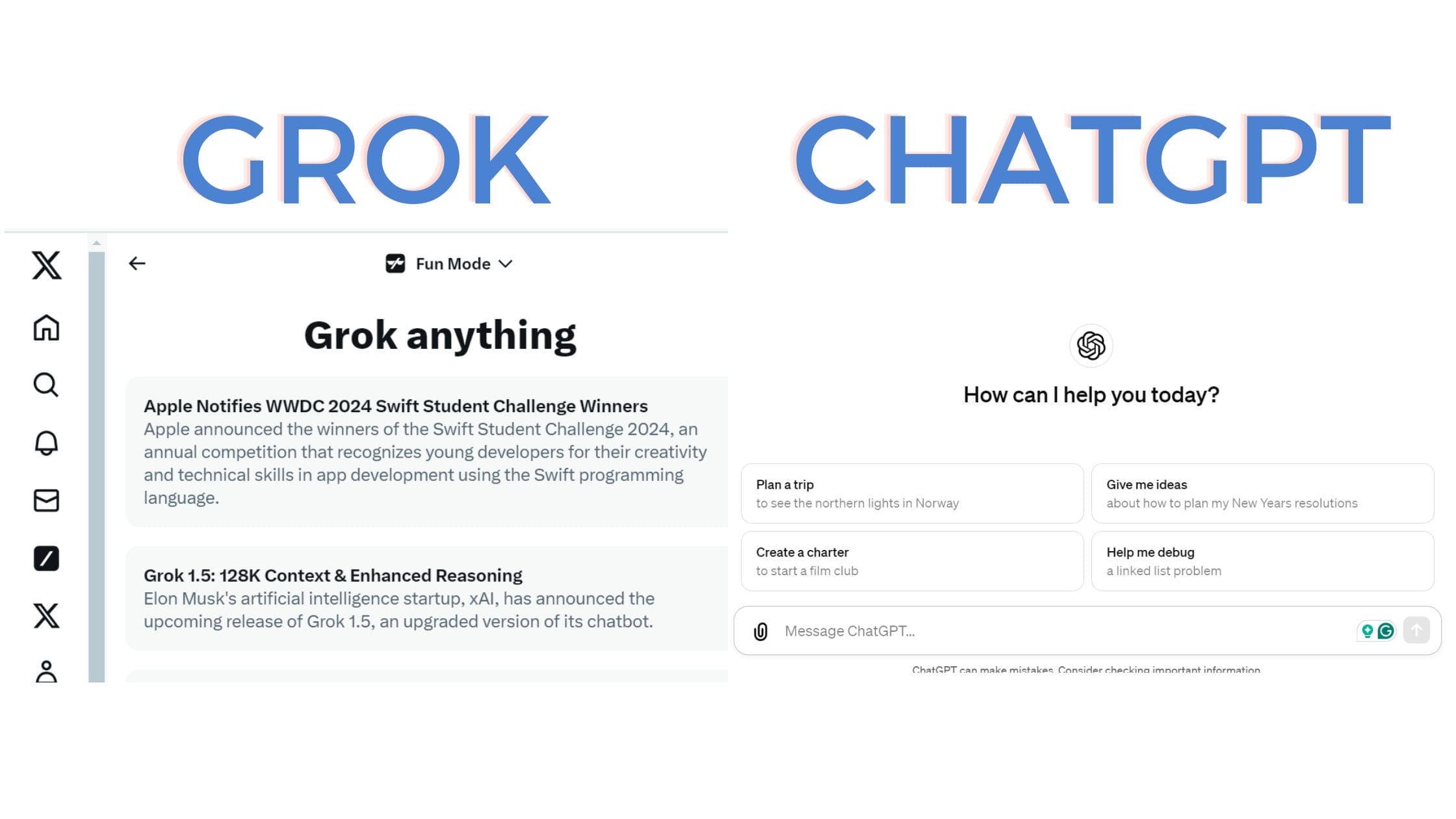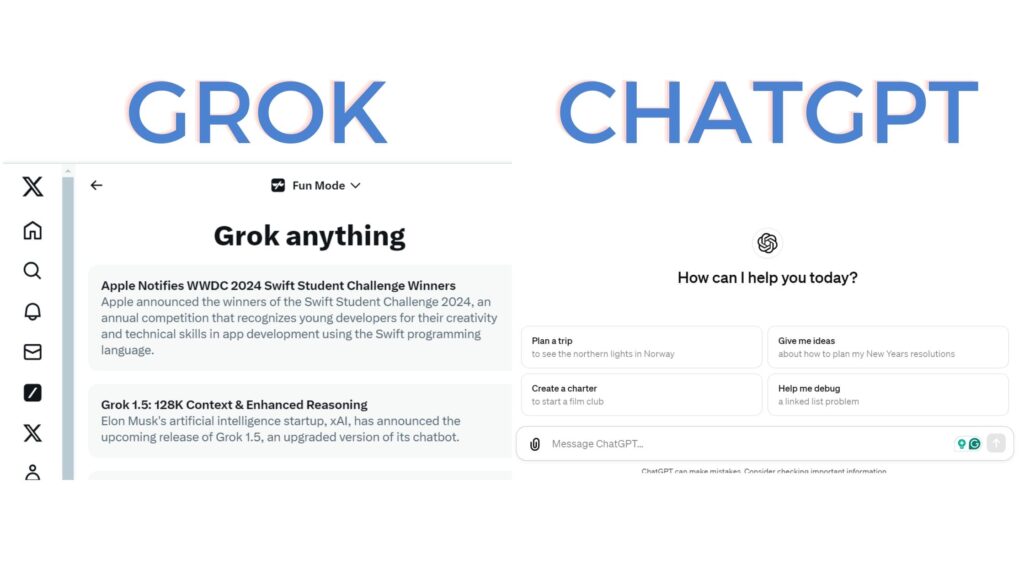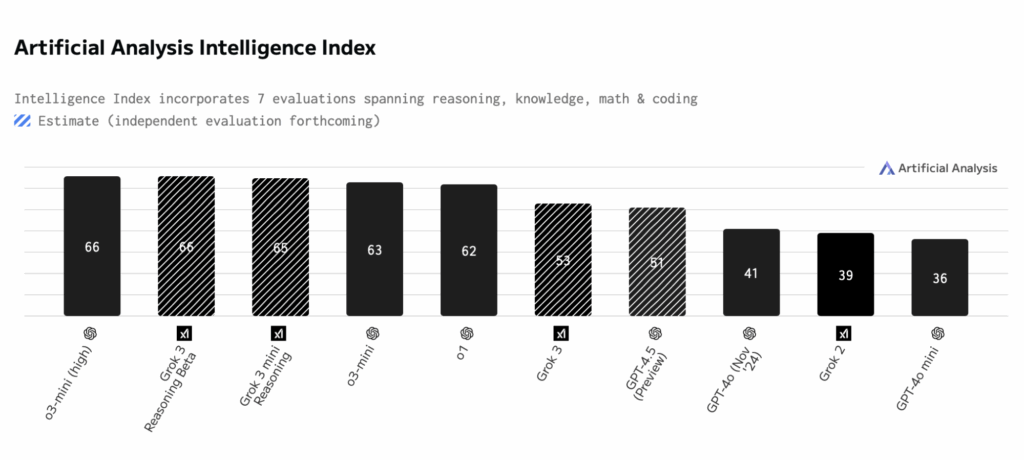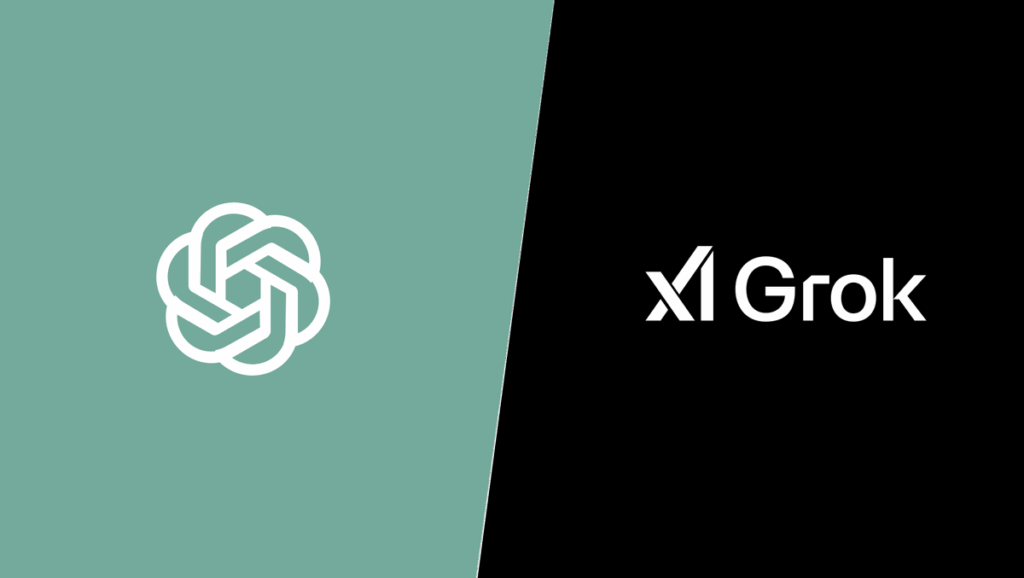The world of Artificial Intelligence (AI) is buzzing, and at its heart are powerful tools designed to understand and generate human-like text. You’ve probably heard the names making headlines: ChatGPT vs Grok. For many, these terms might sound complex, but at AskByteWise.com, our mission is to make complex tech simple. This article is your definitive, friendly guide to understanding the core differences between ChatGPT and Grok, helping you decide which AI chatbot is right for your needs. Whether you’re a student, a small business owner, or just curious about AI, we’ll break down everything you need to know about these fascinating digital assistants.
Understanding the AI Landscape: What Are Large Language Models (LLMs)?
Before we dive into the specifics of ChatGPT and Grok, let’s briefly touch on what kind of technology powers them. Both are examples of Large Language Models (LLMs). Think of an LLM as a super-advanced digital brain that has read an unimaginable amount of text – essentially, a vast digital library containing almost everything ever written on the internet, from books and articles to conversations and code.
This “reading” process is called training. During training, the LLM learns patterns, grammar, facts, and even nuances of human language. It doesn’t “understand” in the human sense, but it becomes incredibly adept at predicting the next most probable word in a sequence. This ability allows it to generate coherent, relevant, and often surprisingly creative responses to your prompts.
Noah’s Insight: Imagine a highly intelligent librarian who has memorized every book in the world. When you ask a question, they don’t just find a book; they synthesize information from countless books to give you a clear, custom-tailored answer. That’s a simplified way to think about how an LLM works.
The Power of Generative AI
Both ChatGPT and Grok fall under the umbrella of Generative AI. This means they can create new content – not just summarize or retrieve existing information. They can write emails, draft articles, brainstorm ideas, write code, tell stories, and even hold conversations that feel remarkably natural. This generative capability is what makes these tools so revolutionary and exciting for everyday users, opening up a world of possibilities for automation and creativity.
ChatGPT: The Pioneer of Conversational AI
ChatGPT, developed by OpenAI, burst onto the scene in late 2022 and quickly became a household name. It’s widely recognized for its impressive ability to engage in natural, flowing conversations and generate high-quality text across a vast range of topics. ChatGPT has been continually refined, with its underlying models (like GPT-3.5 and the more advanced GPT-4) evolving to offer better performance, reasoning, and creativity.
Key Features and Strengths of ChatGPT
- Versatility and Broad Knowledge Base: ChatGPT excels at a wide array of tasks, from answering factual questions and explaining complex concepts to writing creative content and assisting with coding. Its training data encompasses an enormous amount of internet text, making it a generalist powerhouse.
- Sophisticated Language Understanding: It’s renowned for its ability to understand context, follow multi-turn conversations, and produce grammatically correct and coherent responses. This makes it feel incredibly natural to interact with.
- Creative Content Generation: Whether you need a poem, a short story, marketing copy, or even song lyrics, ChatGPT can often deliver surprisingly imaginative and well-structured outputs.
- Plugins and Integrations (for paid versions): More advanced versions of ChatGPT (like GPT-4) can integrate with external tools and services, allowing it to perform actions beyond just generating text, such as browsing the web (if enabled), analyzing data, or interacting with specific applications.
- User-Friendly Interface: OpenAI has made ChatGPT very accessible through a simple web interface, making it easy for anyone to start using it.
Common Use Cases for ChatGPT
- Content Creation: Drafting blog posts, social media updates, marketing materials, or email newsletters.
- Learning and Education: Explaining difficult subjects, summarizing articles, practicing language skills, or preparing for exams.
- Brainstorming and Ideation: Generating ideas for projects, business names, creative writing prompts, or problem-solving.
- Coding Assistance: Writing code snippets, debugging, explaining programming concepts, or converting code from one language to another.
- Customer Service (via APIs): Companies can integrate ChatGPT-like models into their customer support systems to provide instant responses to common queries.
Grok: X’s AI with a Twist
Grok is a relatively newer entrant to the AI chatbot arena, developed by xAI, a company founded by Elon Musk. What sets Grok apart immediately is its direct integration with the X platform (formerly Twitter) and its distinctive “rebellious” and “sarcastic” personality, as described by its creators. Grok aims to provide real-time information and offer a different kind of conversational experience, often with a touch of humor and an unconventional edge.
Key Features and Strengths of Grok
- Real-time Information Access: One of Grok’s standout features is its ability to access information from the X platform in real-time. This means it can discuss current events, trending topics, and recent news much more effectively than models trained only on older datasets.
- Unique Personality and Humor: Grok is designed to have a specific persona, often described as witty, sarcastic, and sometimes edgy. If you appreciate a chatbot that doesn’t shy away from expressing personality, Grok might appeal to you.
- X Integration: Its deep ties to X mean it can pull context from tweets, user profiles, and trending discussions, offering a perspective informed by the platform’s immediate data stream. This is invaluable for analyzing live discussions or understanding public sentiment on breaking news.
- Question Answering (with a twist): Grok is built to answer questions, including those that might be rejected by more cautious AI models due to their sensitive or controversial nature, within ethical boundaries. It’s designed to be more “curious” and less constrained.
- Focus on Current Events: While ChatGPT’s knowledge cutoff means it might not know about very recent events without specific web browsing tools, Grok is inherently designed to be up-to-date with what’s happening right now on X.
Common Use Cases for Grok
- Real-time News and Trends Analysis: Understanding what’s currently trending on X, getting summaries of breaking news, or analyzing public reactions to events as they unfold.
- Generating Edgy or Humorous Content: If your brand or personal style leans towards witty, sarcastic, or unconventional, Grok can help generate content that matches that tone.
- Quick Insights into Public Opinion: For marketers or researchers, Grok can offer a rapid glimpse into sentiment and discussions around specific topics on X.
- Exploring “Unconventional” Questions: For users who appreciate an AI that might offer a more direct, less filtered response to certain queries (within responsible AI guidelines).
- Engaging with X Content: Potentially assisting with drafting replies or understanding context within the X ecosystem.
ChatGPT vs Grok: A Head-to-Head Comparison for Everyday Users
Now that we’ve looked at each AI model individually, let’s put them side-by-side to highlight the key differences you, as a non-technical user, will notice when choosing between ChatGPT vs Grok. This comparison will help you understand which tool aligns better with your specific needs.
Training Data and Real-time Information
- ChatGPT: Primarily trained on a massive dataset of text and code up to a certain cutoff date (which varies by model version, but is generally not real-time). While advanced versions (like GPT-4 with browsing) can access live web data, its core strength isn’t instant news analysis. Think of it as an incredibly well-read scholar whose knowledge is extensive but might be a few months or even a year out of date on the very latest developments.
- Grok: Aims to leverage real-time data from the X platform. This gives it a significant edge when it comes to discussing breaking news, current trends, and live public sentiment. If something just happened, Grok is more likely to be aware of it than a base ChatGPT model without browsing capabilities. Think of Grok as a very opinionated and current news anchor, always tuned into the latest headlines.
Tone and Personality
- ChatGPT: Generally maintains a neutral, helpful, and professional tone. It’s designed to be informative and polite, adapting to the user’s prompt without interjecting its own personality unless specifically asked to do so. Its responses are usually straightforward and factual.
- Grok: Has a distinct, often sarcastic, and “rebellious” personality. It’s built to be witty and sometimes edgy. If you ask it a question, don’t be surprised if its answer comes with a side of humor or a playful challenge. This personality can be a strength for specific use cases but might not be suitable for all professional environments.
Accessibility and Integration
- ChatGPT: Widely accessible through a web browser, and also via APIs for developers. There are free and paid (ChatGPT Plus, Team, Enterprise) versions, with paid versions offering access to more advanced models and features. It’s broadly platform-agnostic.
- Grok: Currently integrated specifically with the X platform and typically available to premium X subscribers. This means its accessibility is tied to your X account status and specific platform.
Strengths and Limitations: Who Wins for What?
Let’s break down the chatgpt vs grok debate in practical terms:
- General Knowledge & Versatility: ChatGPT wins here. Its vast training data makes it a more reliable choice for general questions, creative writing, coding, and in-depth explanations across almost any subject.
- Real-time Current Events: Grok has the edge. If you need insights into what’s happening right now on social media or breaking news, Grok’s X integration gives it a distinct advantage.
- Tone & Persona: This is subjective. If you prefer a neutral, professional assistant, ChatGPT is your go-to. If you enjoy a witty, sarcastic, and sometimes unconventional chatbot, Grok will be more entertaining.
- Creativity (Broad): ChatGPT excels in diverse creative tasks, from poetry to marketing copy.
- Creativity (Specific Tone): If your creative needs specifically lean into sarcasm, humor, or a “rebellious” voice, Grok can be uniquely suited.
- Ease of Access (General): ChatGPT is generally more broadly accessible to anyone with an internet connection.
- Ease of Access (X User): For an existing X Premium user, Grok is seamlessly integrated.
Choosing Your AI Companion: When to Use Which
Deciding between ChatGPT vs Grok really boils down to your primary goal and personal preference.
For Creative Tasks and General Knowledge
If your needs revolve around comprehensive information retrieval, generating diverse creative content, writing assistance for formal documents, coding help, or simply exploring a wide range of topics with a neutral, helpful AI, then ChatGPT is likely your best bet. Its broad capabilities and consistent, professional tone make it an incredibly versatile tool for students, professionals, and creatives alike.
Practical Example: A small business owner might use ChatGPT to draft a marketing email campaign, generate ideas for blog posts, or even get help writing product descriptions. A student could use it to understand a complex historical event or get assistance with a research paper outline.
For Real-time Insights and a Unique Perspective
If you’re particularly interested in what’s happening right now, especially within the fast-paced environment of social media, or if you enjoy an AI with a distinct, humorous, and perhaps cynical personality, then Grok could be a fascinating tool for you. It’s ideal for keeping tabs on trending topics, gauging immediate public reaction, or generating content that breaks from the mold with a touch of wit.
Practical Example: A social media manager might use Grok to quickly understand the sentiment around a breaking news story on X or to brainstorm witty, trending-relevant posts. Someone interested in current events could ask Grok for a summary of reactions to a recent announcement.
The Future of AI Chatbots
The rapid evolution seen with ChatGPT vs Grok is just a glimpse into the future of AI. We can expect these models to become even more sophisticated, capable of understanding multimodal inputs (like images and videos), reasoning more effectively, and performing a wider array of tasks with greater accuracy. The competition between different AI developers, whether it’s OpenAI, xAI, Google, or others, drives innovation, ultimately benefiting users with more powerful, diverse, and accessible AI tools. Expect to see continued advancements in real-time information processing, personalization, and integration with everyday applications. The line between AI assistants and integral parts of our digital lives will only continue to blur.
Conclusion: Your AI Journey Begins
Navigating the world of AI doesn’t have to be overwhelming. When it comes to ChatGPT vs Grok, the choice isn’t about one being definitively “better” than the other; it’s about which tool better suits your specific needs, preferences, and the tasks you want to accomplish.
ChatGPT stands as a remarkably versatile and powerful generalist, excelling in broad knowledge, creative generation, and professional communication. Grok, with its real-time X integration and distinctive personality, offers a specialized alternative for current events analysis and unique, opinionated interactions.
At AskByteWise.com, we believe that understanding these differences empowers you to harness the incredible potential of AI. Experiment with both if you can, see which one resonates with your workflow, and embark on your AI journey with confidence.
Frequently Asked Questions (FAQ)
Q1: Is Grok available to everyone, or do I need an X account?
A1: Grok is currently integrated with the X platform and is generally available to X Premium+ subscribers. Its accessibility is tied to your subscription status on X.
Q2: Can ChatGPT access the internet for real-time information like Grok?
A2: Base versions of ChatGPT (like free GPT-3.5) do not have real-time internet access. However, paid versions of ChatGPT (like ChatGPT Plus with GPT-4) can utilize a web browsing feature to access current information, which helps it overcome its training data cutoff. Grok’s real-time access is inherently tied to its X integration.
Q3: Which AI is better for coding assistance?
A3: For general coding assistance, debugging, explaining code, and generating code snippets across various programming languages, ChatGPT (especially with GPT-4) is widely recognized for its robust capabilities and broader training in code. Grok’s focus is less on coding and more on real-time information and conversational style.
Q4: Can I change Grok’s sarcastic personality to be more neutral?
A4: Grok’s personality is a core design feature. While you can sometimes nudge it by explicitly asking for a more serious or factual tone, its underlying “rebellious” and “sarcastic” nature is inherent to its design. If you consistently need a neutral tone, ChatGPT would be a more suitable choice.
Q5: Are these AI models always accurate?
A5: No. While both ChatGPT and Grok are incredibly advanced, they are not infallible. They can sometimes “hallucinate” or provide incorrect information, especially when dealing with very obscure facts or when asked to predict future events. Always verify critical information obtained from any AI model, particularly for important decisions or factual accuracy.
See more: chatgpt vs grok.
Discover: AskByteWise.



